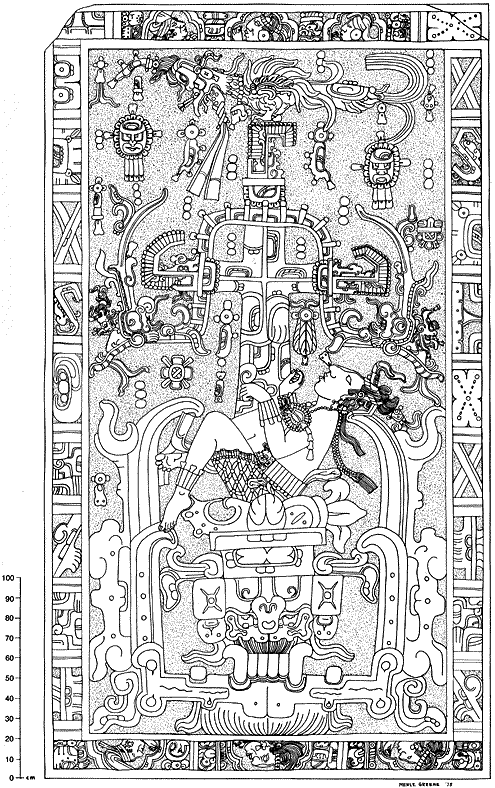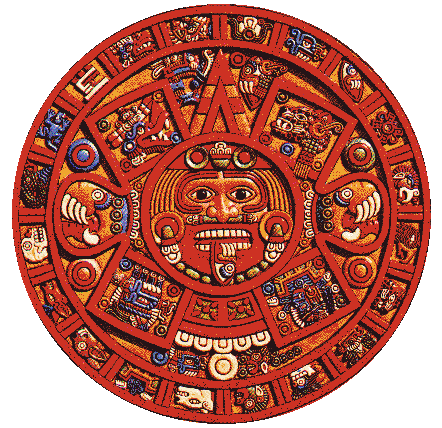The following article was forwarded to me by an old friend and I think the issues are germane to the discussions about Mayan prophecy that some of us have had before in the old forum as well as here.
It has a certain "synchronicity" that I find simultaneously intriguing and serendipitous.
I hope you all enjoy it, Bob, Doc, Saille, et al,

Here is that article. Our e-mail is:
wipfli@bendcable.com
Love from Glory
Subject: Mayan time keepers
The Mayan Calendar: The World will Not End
Carlos Barrios was born into a Spanish family on El Altiplano, the highlands of Guatemala. His home was in Huehuetenango, also the dwelling place of the Maya Mam tribe. With other Maya and other indigenous tradition keepers, the Mam carry part of the old ways on Turtle Island (North America). They are keepers of time, authorities on remarkable calendars that are ancient, elegant and relevant.
Mr. Barrios is an historian, an anthropologist and investigator. After studying with traditional elders for 25 years, since the age of 19, he has also became a Mayan Ajq'ij, a ceremonial priest and spiritual guide, Eagle Clan.
Years ago, along with his brother, Gerardo, Carlos initiated an investigation into the different Mayan calendars. He studied with many teachers. He says his brother Gerardo interviewed nearly 600 traditional
Mayan elders to widen their scope of knowledge.
"Anthropologists visit the temple sites," Mr. Barrios says, "and read the stelas and inscriptions and make up stories about the Maya, but they do not read the signs correctly. It's just their imagination...Other people write about prophecy in the name of the Maya. They say that the world will end in December 2012. The Mayan elders are angry with this.
THE WORLD WIL NOT END.....
IT WILL BE TRANSFORMED!
The indigenous have the calendars, and know how to accurately interpret them, not others."
The Calendars Mayan comprehension of time, seasons, and cycles has proven itself to be vast and sophisticated. The Maya understand 17 different calendars, some of them charting time accurately over a span of more than ten million years. The calendar that has steadily drawn global attention since 1987 is called the Tzolk'in or Cholq'ij. Devised ages ago and based on the cycle of the Pleiades, it is still held as sacred With the indigenous calendars, native people have kept track of important turning points in history. For example, the day keepers who study the calendars identified an important day in the year One Reed, Ce Acatal, as it was called by the Mexicans. That was the day when an important ancestor was prophesied to return, "coming like a butterfly."
In the western calendar, the One Reed date correlates to Easter Sunday, April 21, 1519 the day that Hernando Cortez and his fleet of 11 Spanish galleons arrived from the East at what is today called Vera Cruz, Mexico. When the Spanish ships came toward shore, native people were waiting and watching to see how it would go. The billowing sails of the ships did indeed remind the scouts of butterflies skimming the ocean surface. In this manner was a new era initiated, an era they had anticipated through their calendars. The Maya termed the new era the Nine Bolomtikus, or nine Hells of 52 years each. As the nine cycles unfolded, land and freedom were taken from the native people. Disease and disrespect dominated. What began with the arrival of Cortez, lasted until August 16, 1987 - a date many people recall as Harmonic
Convergence. Millions of people took advantage of that date to make ceremony in sacred sites, praying for a smooth transition to a new era, the World of the Fifth Sun.
From that 1987 date until now, Mr. Barrios says, we have been in a time when the right arm of the materialistic world is disappearing, slowly but inexorably. We are at the cusp of the era when peace begins, and people live in harmony with Mother Earth. We are no longer in the World of the Fourth Sun, but we are not yet in the World of the Fifth Sun. This is the time in-between, the time of transition.
As we pass through transition there is a colossal, global convergence of environmental destruction, social chaos, war, and ongoing Earth changes. All this, Mr. Barrios says, was foreseen via the simple,
spiral mathematics of the Mayan calendars. "It will change," Mr. Barrios observes. "Everything will change." He said Mayan Daykeepers view the Dec. 21, 2012 date as a rebirth, the start of the World of the Fifth Sun. It will be the start of a new era resulting from, and signified by, the solar meridian crossing the galactic equator, and the earth aligning itself with the center of the galaxy.
At sunrise on December 21, 2012 for the first time in 26,000 years the Sun rises to conjunct the intersection of the Milky Way and the plane of the ecliptic. This cosmic cross is considered to be an embodiment of the Sacred Tree, The Tree of Life a tree remembered in all the world's spiritual traditions. Some observers say this alignment with the heart of the galaxy in 2012 will open a channel for cosmic energy to flow through the earth, cleansing it and all that dwells upon it, raising all to a higher level of vibration.
This process has already begun, Mr. Barrios suggested. "Change is accelerating now, and it will continue to accelerate." If the people of the Earth can get to this 2012 date in good shape, without having destroyed too much of the Earth, Mr. Barrios said, we will rise to a new, higher level. But to get there we must transform enormously powerful forces that seek to block the way.
A Picture of the Road Ahead >From his understanding of the Mayan tradition and the calendars, Mr. Barrios offered a picture of where we are at and what may lie on the road ahead:
***The date specified in the calendar: Winter Solstice in the year 2012 does not mark the end of the world.
Many outside people writing about the Mayan calendar sensationalize this date, but they do not know. The ones who know are the indigenous elders who are entrusted with keeping the tradition "Humanity will continue," he contends, "but in a different way. Material structures will change. From this we will have the opportunity to be more human."****
We are living in the most important era of the Mayan calendars and prophecies. All the prophecies of the world, all the traditions, are converging now. There is no time for games. The spiritual ideal of this era
is action. Many powerful souls have reincarnated in this era, with a lot of power. This is true on both sides, the light and the dark. High magic is at work on both sides.
Things will change, but it is up to the people how difficult or easy it is for the changes to come about. The economy now is a fiction. The first five-year stretch of transition from August 1987 to August 1992 was the beginning of the destruction of the material world. We have progressed ten years deeper into the transition phase by now, and many of the so-called sources of financial stability are in fact hollow.
The banks are weak. This is a delicate moment for them. They could crash globally if we don't pay attention. One critical period is October and November 2002. If the banks crash in these months then we will be forced to rely on the land and our skills. The monetary systems will be in chaos, and we must then rely on our direct relationship with the Earth for our food and shelter. The North and South Poles are both breaking up. The level of the water in the oceans is going to rise. But at the same time land in the ocean, especially near Cuba, is also going to rise.
A Call for Fusion
As he met with audiences in Santa Fe, Mr. Barrios told story about the most recent Mayan New Year ceremonies in Guatemala. He said that one respected Mayan elder, who lives all year in a solitary mountain cave, journeyed to Chichicastenango to speak with the people at the ceremony. The elder delivered a simple, direct message. He called for human beings to come together in support of life and light. Right now each person and group is going his or her own way. The elder of the mountains said there is hope if the people of the light can come together and unite in some way.
Reflecting on this, Mr. Barrios explained:
"We live in a world of polarity:
day and night, man and woman, positive and negative. Light and darkness need each other. They are a balance. Just now the dark side is very strong, and very clear about what they want. They have their vision and their priorities clearly held, and also their hierarchy. They are working in many ways so that we will be unable to connect with the spiral Fifth World in 2012."
"On the light side everyone thinks they are the most important, that their own understandings, or their group's understandings, are the key. There's a diversity of cultures and opinions, so there is competition, diffusion, and no single focus."
As Mr. Barrios sees it, the dark side works to block fusion through denial and materialism. It also works to destroy those who are working with the light to get the Earth to a higher level. They like the energy of the old, declining Fourth World, the materialism. They do not want it to change. They do not want fusion. They want to stay at this level, and are afraid of the next level.
****The dark power of the declining Fourth World cannot be destroyed or overpowered. It's too strong and clear for that, and that is the wrong strategy. The dark can only be transformed when confronted with simplicity and open-heartedness. This is what leads to fusion, a key concept for the World of the Fifth Sun.****
Mr. Barrios said the emerging era of the Fifth Sun will call attention to a much-overlooked element. Whereas the four traditional elements of earth, air, fire and water have dominated various epochs in the past, there will be a fifth element to reckon with in the time of the Fifth Sun: ether. The dictionary defines ether as the rarefied element of the Heavens. Ether is a medium. It permeates all space and transmits waves of energy in a wide range of frequencies, from cell phones to human auras. What is "ethereal" is related to the regions beyond earth: the heavens.
Ether the element of the Fifth Sun is celestial and lacking in material substance, but is no less real than wood, stone or flesh. "Within the context of ether there can be a fusion of the polarities," Mr. Barrios said.
"No more darkness or light in the people, but an uplifted fusion. But right now the realm of darkness is not interested in this. They are organized to block it. They seek to unbalance the Earth and its environment so we will be unready for the alignment in 2012. We need to work together for peace, and balance with the other side. We need to take care of the Earth that feeds and shelters us. We need to put our entire mind and heart into pursuing unity and fusion now, to confront the other side and preserve life."
To be Ready for this Moment in History Mr. Barrios told his audiences in Santa Fe that we are at a critical moment of world history. "We are disturbed," he said. "We can't play anymore. Our planet can be renewed or ravaged. Now is the time to awaken and take action." "Everyone is needed. You are not here for no reason. Everyone who is here now has an important purpose. This is a hard, but a special time. We have the opportunity for growth, but we must be ready for this moment in history."
Mr. Barrios offered a number of suggestions to help people walk in balance through the years ahead. "The prophesied changes are going to happen," he said "but our attitude and actions determine how harsh or mild they are."
We need to act, to make changes, and to elect people to represent us who understand and who will take political action to respect the earth. Meditation and spiritual practice are good, but also action. It's very important to be clear about who you are, and also about your relation to the Earth.
Develop yourself according to your own tradition and the call of your heart. But remember to respect differences, and strive for unity. Eat wisely. A lot of food is corrupt in either subtle or gross ways. Pay attention to what you are taking into your body. Learn to preserve food, and to conserve energy.
Learn some good breathing techniques, so you have mastery of your breath.
Be clear. Follow a tradition with great roots. It is not important what tradition, your heart will tell you, but it must have great roots. We live in a world of energy.
An important task at this time is to learn to sense or see the energy of everyone and everything: people, plants, animals. This becomes increasingly important as we draw close to the World of the Fifth Sun, for it is associated with the element ether -- the realm where energy lives and weaves.
Go to the sacred places of the earth to pray for peace, and respect for the Earth which gives us our food, clothing, and shelter. We need to reactivate the energy of these sacred places. That is our work.
****According to Mr. Barrios' reading of the Mayan calendar, if war happens in November 2002 or after, then it's bad, but not catastrophic. But if it happens between April and November 2003, it will be catastrophic. Really bad. It could eventually result in the death of two-thirds of humanity. "So stay active," he said. "If we are active, we can transform the planet. The elders watch to see what happens."****
Many Mayan elders and knowledge keepers may be eliminated in the next few years. For the first half of the current Katun (20-year period) the dark side has a lot of power. But that will pass 3 to 4 years from now. The tide can turn. Amazing things are going to happen.
****One simple but effective prayer technique is to light a white or baby-blue colored candle. Think a moment in peace. Speak your intention to the flame and send the light of it on to the leaders who have the power to make war or peace.****
We Have Work to Do
According to Mr. Barrios this is a crucially important moment for humanity, and for earth. Each person is important. If you have incarnated into this era, you have spiritual work to do balancing the planet. He said the elders have opened the doors so that other races can come to the Mayan world to receive the tradition. The Maya have long appreciated and respected that there are other colors, other races, and other spiritual systems. "They know," he said, "that the destiny of the Mayan world is related to the destiny of the whole world."
"The greatest wisdom is in simplicity," Mr. Barrios advised before leaving Santa Fe. "Love, respect, tolerance, sharing, gratitude, forgiveness. It's not complex or elaborate. The real knowledge is free. It's encoded in your DNA. All you need is within you. Great teachers have said that from the beginning.
Find your heart, and you will find your way."








































